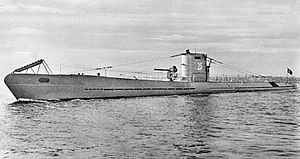Type I submarine
 U-25,a Type I U-boat.
| |
| Class overview | |
|---|---|
| Builders | Deschimag,Bremen |
| Operators | |
| Preceded by | Spanish Type E1 |
| Succeeded by | |
| Cost | 4,500,000ℛ︁ℳ︁ |
| In commission | 1936 – 1940 |
| Planned | 2 |
| Completed | 2 |
| Lost | 2 |
| General characteristics | |
| Displacement |
|
| Length | 72.39 m (237 ft 6 in) |
| Beam | 6.21 m (20 ft 4 in) |
| Draft | 4.30 m (14 ft 1 in) |
| Propulsion |
|
| Speed | |
| Range |
|
| Test depth | 200 m (660 ft) |
| Complement | 4 officers, 39 enlisted |
| Armament |
|
TheType IU-boatwas the first post–World War Iattempt to produce an oceangoing submarine forNazi Germany'sKriegsmarine.The type was based on theSpanish Type E-1[1]and FinnishCV707,which were both designed byIngenieurskantoor voor Scheepsbouw.[2]Only two Type IAs were built.[3]They were not a successful design: due to its single rudder they had a large turning circle and were not very manoeuvrable. The gravity center of the U-boat was too forward so on the surface the type I had its propellers exposed when she was pitching. Whilst submerged there were problems with depth keeping and stability as air bubbles in the fuel tanks wobbled back and forth. Diving was very slow: at full speed and with six tons of negative buoyancy it took forty seconds to reach ten metres depth. As a result, the type was discontinued and a newtype IXclass oceangoing U-boats was designed.[4]
Service history[edit]
Constructed byDeschimaginBremen,the first Type IA was launched on 14 February 1936.[5]The two boats produced,U-25andU-26,were primarily used as training vessels and for propaganda purposes to fly theNaziflag. In 1940, the boats were called into combat duty due to the shortage of available submarines.[6]Both boats experienced short, but successful combat careers.U-25participated in five war cruises, sinking eight enemy ships. On 3 August 1940, while on a mine laying mission nearNorway,U-25struck a mine and sank with all hands on board.[1]
U-26carried out eight war cruises, sinking three merchant ships on its first mission laying mines. On its second war cruise it became the first U-boat duringWorld War IIto enter theMediterranean Sea.U-26participated in three other successful war patrols, sinking four additional merchant ships. On its eighth war cruise the boat sank three merchant ships and damaged another ship the next day. The attack on this ship led to severe depth-charging by two British warships, includingHMSGladiolus.[1]Unable to dive,U-26was forced to surface where she was bombed by aSunderland flying boat.The crew scuttled the submarine and were rescued byAlliedwarships.
List of Type I submarines[edit]
References[edit]
- ^abcGröner 1991,p. 39.
- ^Rössler (2001), pp. 98-99.
- ^Showell (2006), p. 73.
- ^Paterson 2003,p. x-xi.
- ^Sharpe (1998), p. 13.
- ^Williamson (2005), p. 16.
Bibliography[edit]
- Gröner, Erich; Jung, Dieter; Maass, Martin (1991).German Warships 1815–1945, U-boats and Mine Warfare Vessels.Vol. 2. Translated by Thomas, Keith; Magowan, Rachel. London: Conway Maritime Press.ISBN0-85177-593-4.
- Paterson, Lawrence (2003).Second U-Boat Flottila.Leo Cooper.ISBN0-85052-917-4.
- Sharpe, Peter (1998).U-Boat Fact File: Detailed Service Histories of the Submarines Operated by the Kriegsmarine 1935-1945.Leicester: Midland Publishing.ISBN1-85780-072-9.
- Showell, Jak P. Mallmann (2006).The U-boat Century: German Submarine Warfare 1906-2006.London: Chatham Publishing.ISBN9781861762412.
- Rössler, Eberhard (2001).The U-boat: The evolution and technical history of German submarines.London: Cassell & Co.ISBN0-304-36120-8.
- Williamson, Gordon (2005).Wolf Pack: The Story of the U-boat in World War II.Oxford: Osprey Publishing.ISBN1-84176-872-3.
External links[edit]
- "U-Boat Aces.com".U-Boat Types – Type IA U-Boat.Retrieved31 July2006.
- Helgason, Guðmundur."U-Boat Types – Type IA".German U-boats of World War II - Uboat.net.Retrieved31 July2006.
